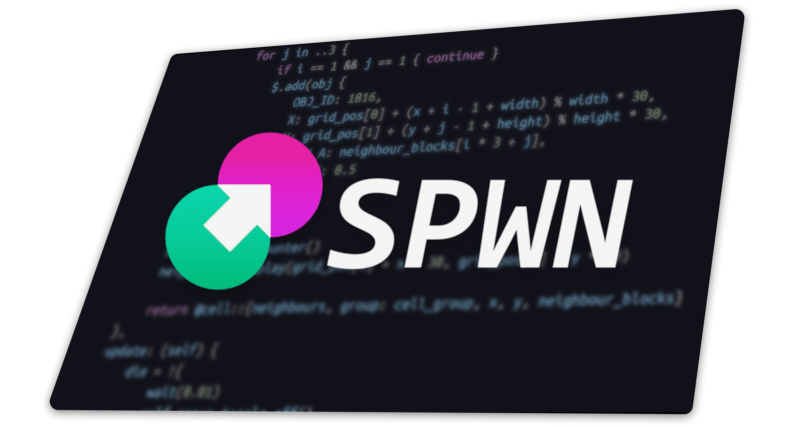1 unstable release
| 0.0.6 | Aug 21, 2021 |
|---|
#875 in Cryptography
630KB
13K
SLoC

SPWN Language
A language for Geometry Dash triggers. An easy way to create levels using code.
SPWN is a programming language that compiles to Geometry Dash levels. What that means is that you can create levels by using not only the visual representation in the GD-editor, but using a "verbal" and abstracted representation as well. This is especially useful for using GD triggers, which (if you want to make complicated stuff) are not really suited for the graphical workflow of the in-game editor.
Useful links
- Official SPWN documentation - link
- Documentation Repository - link
- Official SPWN Discord server - link
Installing - How To Install
You can either use the installers for your operating system, or build SPWN from source. Please note that building from source will give you access to newer features and bug fixes, but may be unstable.
Windows
- Download the .msi file from the latest release.
- Open the .msi file and follow the install wizard.
MacOS
- Download the .pkg file from the latest release.
- Open the .pkg file and follow the install wizard.
- Note: If you get a message telling you that you cant open files from unidentified developers, open 'System Preferences' then click 'Security & Privacy' and click 'Open Anyway' on the 'General' menu
Linux
Debian (Ubuntu, Mint, Elementary, ...)
- Download the .deb file (debian based) or the .pkg.tar.zst (arch based) from the latest release
- Install the debian package using dpkg:
sudo dpkg -i spwn_0.0.6-0_amd64.deb
Arch (Manjaro, Artix, ...)
- Install the arch package using pacman:
pacman -U spwn-0.0.6_amd64.pkg.tar.zst
- Alternatively, you can install the SPWN binary from the AUR (replace yay with your helper of choice):
yay -S spwn-bin
Compiling from source
- Download source code from this repository
- Unzip the .zip file
- Install rust if you haven't already
- Open the unzipped folder in the terminal
- Run
cargo build --release - Compiled binary is placed in
target/release
Using SPWN - Setup
Alright, enough talk, how do we actually use SPWN?
SPWN code can be programmed in any code editor, but the ones that have had SPWN extensions or plugins written for them are Visual Studio Code, Sublime Text and Vim.
VSCode
Navigate to VSCode SPWN language support and hit install. In VSCode, hit enable and then create a new file with the extension .spwn
- Note: Make sure to have the file in the same directory as the libraries folder
VSCode should automatically change the language syntax to SPWN, but if it doesn't, navigate to the bottom right of the screen and click on
select language mode, then select SPWN.
Sublime Text
Open Sublime Text and open the Command Palette... by selecting Command Palette from the Tools pull-down menu. In the menu that opens type install which will result in the Install Package Control option being presented. Hit Enter or left click the entry to install Package Control. Open the Command Palette again, and type 'install'. When Package Control: Install Package is highlighted press 'Enter' then type 'SPWN Language' and press 'Enter' when SPWN Language is highlighted.
Vim
Go to spwn().vim! and follow to instructions on that page.
Other Editors
For any other editor with syntax highlighting, most C type syntax highlighting schemes work fine.
Using SPWN - How to run SPWN Code
Head to the docs to create a simple program, such as the one below
test = 5g
-> test.move(5, 100, 0.25)
test.move(10, -10, 2)
Save the file, then open a terminal and type in spwn build YOURFILENAME.spwn. Make sure to have GD closed during this process. After running this command, open GD, and the levels content will be modified. Head over to the docs to learn how to program in SPWN.
Note: SPWN generates triggers near the top of your level, so you might not see any difference.
Using SPWN - Command Line Reference
Here is a list of SPWN command line subcommands and flags. This information can be found by typing spwn help in the command line as well.
Subcommands:
build [script file], b [script file]
Runs/builds a given file
doc [library path]
Generates documentation for a SPWN library, in the form of a markdown file
version, -v, --version
Gets the version of spwn
Flags:
--console-output, -c
Makes the script print the created level into the console instead of
writing it to your save file
--no-level, -l
Only compiles the script, no level creation at all
--no-optimize, -o
Removes post-optimization of triggers, making the output more readable,
while also using a lot more objects and groups
--level-name [name], -n [name]
Targets a specific level
--live-editor, -e
Instead of writing the level to the save file, the script will use a
live editor library if it's installed (Currently works only for MacOS)
--save-file [file], -s [file]
Chooses a specific save file to write to
--include-path [folder], -i [folder]
Adds a search path to look for libraries
Examples:
spwn build addition.spwn --level-name add
Build a file called addition.spwn and write it to the level named add.
spwn build subtraction.spwn --no-level
Build a file called subtraction.spwn but don't write to a level.
spwn build AI.spwn -c
Build a file called AI.spwn and output the level string to the console.
Todo before release:
- Finish mutable variables
- Type annotations for function arguments, variable definitions etc.
-
asoperator for automatically changing type - finish documentation
- break/continue statement
- operation order
- escaped characters in string
- fix post-compile optimizations
Todo at some point
- implement live editor features for windows
- make it work on linux
- nested comments
- get and edit obj and trigger properties
Enjoy SPWN!
Dependencies
~11–21MB
~289K SLoC